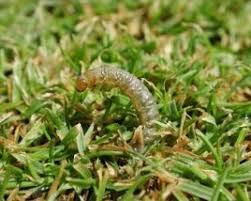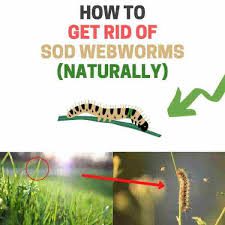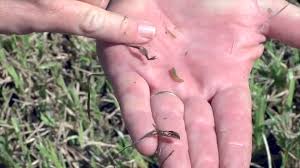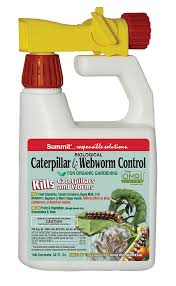Sod Worms, also known as lawn caterpillars, are little insects that can cause problems for your grass. These tiny creatures munch on the grass blades, which can lead to brown and patchy areas in your lawn. Sod worms like warm weather, so they usually appear in the summer months when it’s hot outside.
You might wonder how to spot these sod worms. Well, if you notice areas of your grass turning brown or thinning out, there’s a chance that sod worms are at work. They have a preference for chewing on the grass close to the soil, which can make it look like someone mowed your lawn unevenly.
It is very important to take action if you think sod worms are causing trouble in your yard. There are a few methods you can use to deal with them. One way is to keep your lawn healthy by watering it properly and giving it the right nutrients. A healthy lawn can recover from sod worm damage more easily.
Another approach is to use insecticides that are made to target these worms. These chemicals can be sprayed onto the grass to kill the sod worms. However, it’s important to follow the instructions carefully and not use too much, as it can harm other insects and animals in your yard.
If you don’t want to use chemicals, you can also try using beneficial nematodes. These are tiny organisms that naturally occur in the soil and can feed on sod worms. By releasing them into your lawn, you can create a natural balance that keeps sod worm populations in check.
In addition, sod worms might be small, but they can cause big problems for your lawn. Keep an eye out for brown patches and thinning grass, especially in the summer. If you suspect sod worms are causing the issue, you can try different methods like keeping your lawn healthy, using insecticides, or introducing beneficial nematodes. With the right approach, you can keep your lawn looking lush and green, even in the face of these little critters.
Causes of Sod Worms

Sod worms, also known as lawn caterpillars, can cause damage to your lawn. These tiny insects eat the grass blades, which can lead to problems like brown and patchy areas in your yard. Sod worms prefer warm weather, so they often appear in the summer months when it’s hot outside.
The damage they cause is noticeable when parts of your grass turn brown or thin out. Sod worms tend to chew the grass near the soil, which can make your lawn look uneven and poorly mowed.
It’s important to identify the causes of sod worm infestations. Factors that contribute to their presence include warm weather conditions, lack of proper lawn care, and the absence of natural predators. Overwatering and over-fertilizing can also create an environment where sod worms thrive.
To prevent sod worm infestations, it’s important to maintain proper lawn care practices. Avoid overwatering and over-fertilizing, as these can create conditions that attract sod worms. Regularly mow your lawn to the recommended height and keep it healthy by providing the right nutrients and water.
If you notice signs of sod worm damage, take action promptly. This can include using insecticides that target sod worms, introducing beneficial nematodes, or making sure your lawn is in good health to recover from the damage.
However, sod worms can be a nuisance to your lawn, causing brown patches and thinning grass. Warm weather and improper lawn care practices can contribute to their presence. By understanding the causes of sod worm infestations and taking appropriate measures, you can help keep your lawn healthy and free from their damaging effects.
Read Also: Significance And Uses of Craspedia Flower
How to prevent Sod Worms

Preventing sod worm infestations in your lawn is essential to maintaining its health and appearance. Here are some simple and effective preventive measures you can take:
1. Proper Lawn Care: One of the best ways to prevent sod worms is by maintaining a healthy lawn. Regularly mow your grass to the recommended height and avoid cutting it too short, as this can weaken the grass and make it more susceptible to pests.
2. Adequate Watering: Water your lawn deeply and less frequently, rather than shallow and often. This encourages deep root growth and discourages sod worms, which prefer moist conditions near the surface.
3. Appropriate Fertilization: Avoid over-fertilizing your lawn, as excessive nitrogen can attract sod worms. Use a balanced fertilizer and follow recommended application rates.
4. Lawn Aeration: Aerating your lawn can improve soil drainage and reduce thatch buildup, creating an environment less favorable for sod worms.
5. Beneficial Nematodes: Introduce beneficial nematodes to your lawn. These microscopic organisms are natural predators of sod worms and can help control their population.
6. Natural Predators: Encourage natural predators of sod worms, such as birds and certain insects, to visit your lawn. Creating a diverse ecosystem can help keep sod worm populations in check.
7. Regular Inspection: Periodically inspect your lawn for signs of sod worm damage, such as brown patches or thinning grass. Early detection can help you address the issue before it becomes severe.
8. Remove Thatch: Thatch, a layer of dead grass and debris, can provide a hiding place for sod worms. Regularly dethatch your lawn to reduce their hiding spots.
9. Proper Planting: Choose grass varieties that are less susceptible to sod worm damage. Consult with local experts to determine the best grass types for your region.
10. Avoid Overwatering: Sod worms thrive in moist conditions. By avoiding overwatering, you can create an environment that is less favorable for their growth.
11. Clean Garden Tools: If you’ve been working in an area with sod worm infestations, make sure to clean your garden tools thoroughly before moving to another area. This can prevent the spread of the pests.
By implementing these preventive measures, you can significantly reduce the risk of sod worm infestations and keep your lawn looking healthy and vibrant. Remember that a combination of proper lawn care practices and natural solutions can go a long way in protecting your lawn from these pesky insects.
Caring for Affected Sod Grass by Sod Worms

If your sod grass is already infested with worms, there are steps you can take to care for your lawn and address the issue:
1. Identification: First, make sure you correctly identify the type of worms causing the issue. Different types of worms may require different treatments.
2. Remove Debris: Clear away any debris, thatch, or dead grass from the affected areas. This can help improve air circulation and make it harder for the worms to hide.
3. Inspect Regularly: Keep a close eye on your lawn to monitor the extent of the infestation. Regular inspections will help you track the progress of your treatment efforts.
4. Adjust Watering: While it’s important to keep your lawn adequately watered, avoid overwatering. Sod worms thrive in moist conditions, so adjusting your watering routine can discourage their growth.
5. Apply Beneficial Nematodes: Introduce beneficial nematodes to your lawn. These natural predators can help control the worm population.
6. Use Natural Controls: Consider using natural remedies such as diatomaceous earth or neem oil, which can deter and control worm infestations.
7. Insecticides: If the infestation is severe, you might need to use insecticides specifically formulated to target the worms. Follow the instructions on the product carefully and consider using eco-friendly options if available.
8. Reseed Damaged Areas: If the worm damage has caused bare spots, reseed those areas once the worm population is under control.
9. Regular Mowing: Continue to mow your lawn regularly at the recommended height. This can help weaken the worms and promote healthier grass growth.
10. Lawn Recovery: After addressing the worm infestation, focus on overall lawn recovery. Provide proper fertilization, aeration, and overseeding to help your lawn regain its health and density.
11. Maintain Prevention: Even after addressing the current infestation, it’s important to continue with preventive measures to avoid future problems with sod worms.
Remember that recovering from a worm infestation might take time, so be patient and persistent in your efforts. If you’re uncertain about the best course of action, consider consulting with a local lawn care professional who can provide tailored advice based on your specific situation and the types of worms present.
Read Also: Vanilla Flower (Vanilla planifolia): All You Need To Know About
Best Insecticide for Sod Worms

When choosing an insecticide to address a sod worm infestation, it’s important to consider both its effectiveness and its potential impact on the environment, beneficial insects, and other animals. Here are a few options that are commonly used and considered effective:
1. Bacillus thuringiensis (Bt): Bt is a naturally occurring bacterium that produces proteins toxic to certain insect larvae, including sod worms. It specifically targets caterpillars while being relatively safe for humans, pets, and beneficial insects. Bt-based insecticides are available in various formulations.
2. Spinosad: Spinosad is a biopesticide derived from a soil bacterium. It’s effective against a range of insect pests, including sod worms. It’s considered safe for humans, pets, and many beneficial insects when used as directed.
3. Neem Oil: Neem oil is derived from the neem tree and works by disrupting the growth and development of insect pests. It can be effective against sod worms and is considered relatively low in toxicity to humans and pets. However, it’s important to follow proper application guidelines.
4. Pyrethrin-Based Insecticides: Pyrethrin is a natural insecticide derived from chrysanthemum flowers. It works by targeting the nervous system of insects. Pyrethrin-based insecticides are effective against various pests, including sod worms. They generally break down quickly in the environment.
5. Insecticidal Soaps: Insecticidal soaps are mild and are used to smother and kill soft-bodied insects, including caterpillars. They can be effective against smaller infestations of sod worms.
Before using any insecticide, carefully read and follow the instructions on the product label. It’s essential to apply the insecticide according to the recommended rates and timing. Also, consider the potential impact on beneficial insects, such as bees and ladybugs, which play important roles in your ecosystem.
If you are not sure about which insecticide to use or how to apply it, consider seeking advice from a local garden center, nursery, or lawn care professional. They can provide guidance based on your specific situation and local conditions. Additionally, consider using integrated pest management (IPM) strategies that focus on a combination of preventive measures, cultural practices, and targeted treatments to effectively manage pest issues while minimizing environmental impact.
Read Also: Lakeshore Recycling Systems (LRS) Complete Guide
